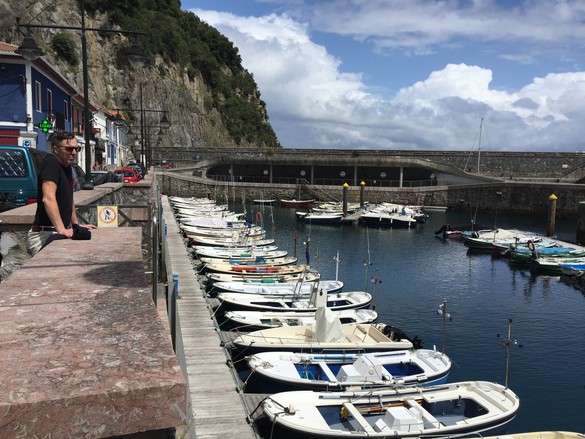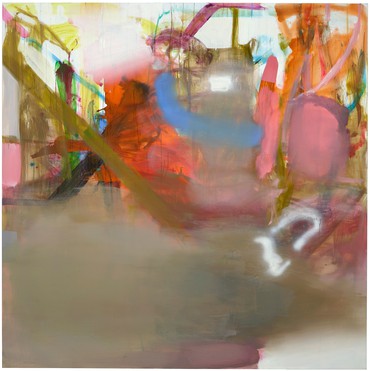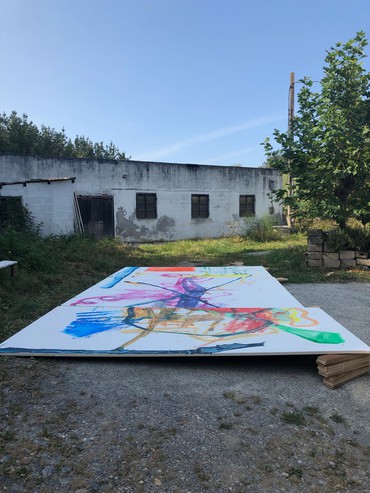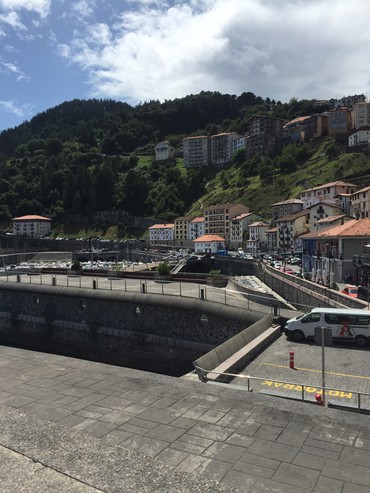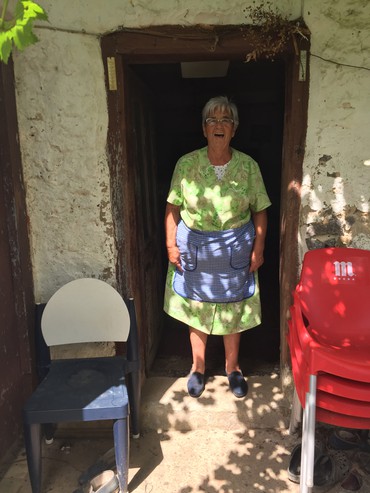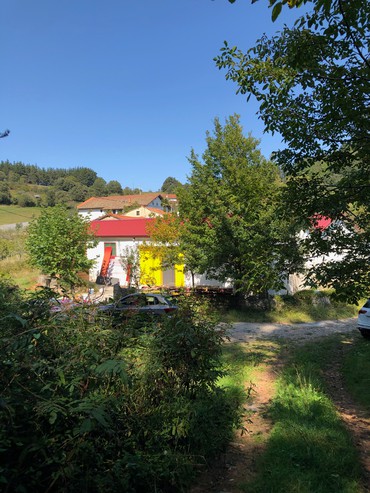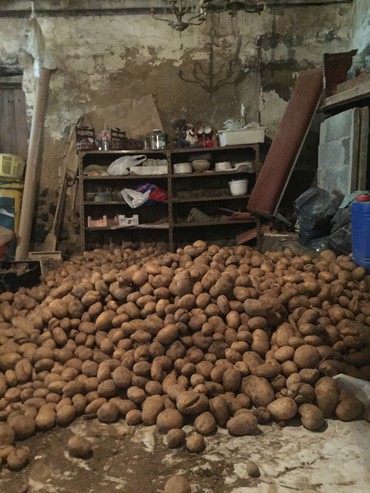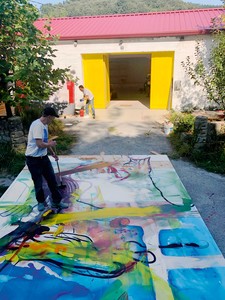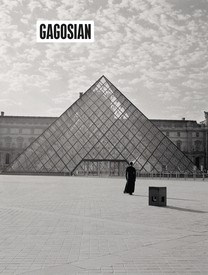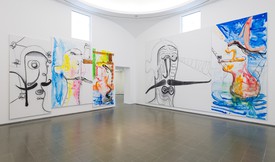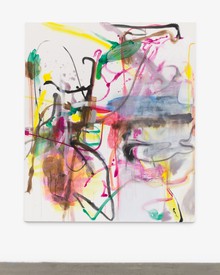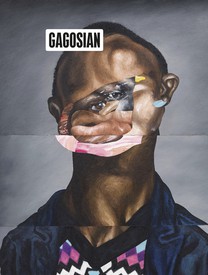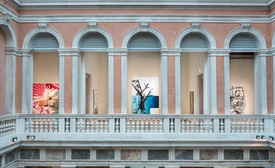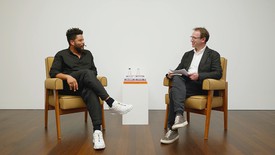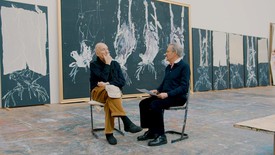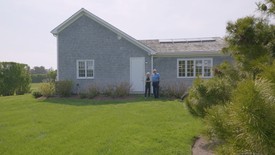
Mark Godfrey is an art historian and curator based in London. From 2007 to 2021 he was senior curator of international art at Tate Modern, London, where he curated and co-curated retrospectives of Gerhard Richter, Sigmar Polke, Alighiero Boetti, Franz West, and others, as well as the acclaimed exhibition Soul of a Nation: Art in the Age of Black Power. He is currently working on projects with Anicka Yi, Laura Owens, and Jacqueline Humphries.
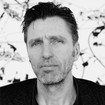
Albert Oehlen’s oeuvre is a testament to the innate freedom of the creative act. Through expressionist brushwork, surrealist methodology, and self-conscious amateurism he engages with the history of abstract painting, pushing the basic components of abstraction to new extremes. Photo: Oliver Schultz-Berndt
Mark Godfrey You spent some time in Los Angeles recently. Was this the first group of work you made when you got back home to Switzerland?
Albert OehlenExactly, they were what I did right after coming back. I didn’t have any pressure to work, I just wanted to kill some time. I started them, like I started the paintings I made in LA, with water-based colors, extremely thin—so they were very colorful. But somehow this drifted away—I went with oil on them and they became what they are now.
MGThe paintings you made in LA were the watercolors that you showed in Hong Kong in 2019. So these more recent paintings began with watercolor, but they have lacquer and oil and acrylic as well. How do the different types of paint play on the surface? Do they reflect light differently?
AOI don’t know if I can describe it, but there’s a clear difference. The watercolors are matte but the colors are very brilliant, they’re shiny because they’re sitting on the white of the canvas. And with oil paintings, at least in my case, it’s the opposite—the colors are muddy, or become that after a while, but the paint is glossy sometimes.
MGIn recent years, you’ve used metal stencils and rulers, brushes, spray paints. What kinds of materials or implements were you using in these paintings?
AOIn these paintings, nothing, just paint, and quite a lot of paint medium in the oil.
MGBut in terms of applying the paint—there are areas of spray paint, right? Or not?
AOOh yeah, I sprayed a little bit, yes. But there’s nothing else besides that.
MGThese paintings seem to me—more than other recent groups of works, like the Elevator Paintings, which were shown in New York in 2017, or the watercolors shown in Hong Kong in 2019—to go back to the language of your first abstract paintings in the period of, let’s say, 1987 to 1992. There’s the same mix of strong diagonal lines—in Akademisch [2020], for example, there’s an X in the top left corner, and in others there are strong straight lines. Then there are ellipsoid shapes, curvy shapes, and lots of drips. And then there’s all the muddy, sludgy stuff. I wondered whether you thought about these paintings as somehow remixing or going back to the quality of that earlier work.
AOYes, it surprised me that it got there. I saw it after a while, that I was coming very close to the 1990s paintings, and I had nothing against it but I didn’t plan to go back to older ways of painting. It’s rather a surprise to me that under certain circumstances, this comes out, and it seems to mean something to me.
Film by Albert Oehlen, with music by Tim Berresheim
MGIt’s interesting that you say that there was no plan. If I look at the Elevator Paintings with an art historian’s eye, I would say that two of those paintings seem to deliberately quote older artists. One of them seems to quote Frank Stella and another seems to quote Gerhard Richter’s Color Charts—
AOOh, yes.
MG—where you’re playing with both of those precedents in a quite deliberate, sort of jokey way. But here, it sounds like you surprised yourself by making works that have some relationship to that first group of abstract paintings.
AOYeah, there was no plan in these paintings. I just went to the studio, found some material, and did something under the impression of what I did before and let it go where it wanted. So sometimes the explanation is unspectacular [laughs]—but still, it might result in a work that might be even better than others, if I’m lucky. What I’m saying is that the most interesting painting might have the least to talk about [laughs].
MGLet’s take one of them. What I really like about Akademisch is the balance between how much is going on in the top of the painting and the blurry, smudgy, muddy area at the bottom. You once called areas like that a “muddy stew.”
AOYes.
MG It’s a great phrase. Again, with an art historian’s hat, I want to compare these areas of muddiness with a very famous painting, which is Richter’s first painting, Tisch [Table, 1962], where he took a photograph of a designer table, made a painting about that, and then sort of erased it right in the center. It was a very deliberate confrontation of the image and abstraction. What you’ve always done is very different in tone, but when you produce this sort of smudgy brown mess in one area, what are you doing with that painting?
AOThere is more than one reason to get there, but one that comes to my mind is, for example, when you analyze abstract paintings, you see the logical necessities that repeat. And normally, when something is more in a field and there is a line, then the line would sit on the field and not the other way around.
MGYes.
I was thinking about these habits that one has, and I was trying to reverse them all. whenever I find something, it makes me think, What if I don’t do that, or what if I do the opposite?
Albert Oehlen
AOThat’s what you naturally do. There are habits in painting that you don’t think about, and one of these habits comes from the desire that you see what you have done [laughs]. It sounds logical that if you paint something, you want it to be seen and not the opposite.
I was thinking about these habits that one has, and I was trying to reverse them all. Whenever I find something, it makes me think, What if I don’t do that, or what if I do the opposite? And then other ideas come, like, Can you paint the painting from the other side? And that leads to other thoughts, like, From where to where do you paint? Do you paint like you write, from the left upper corner to the lower right? Do you paint from the background to the foreground, or the other way around? All these thoughts are what I’m having fun with when I’m painting.
MGIf I look at Akademisch, it seems that the area in the bottom left comes over whatever was below that and was pretty much one of the last things that you did, to cancel out some of the painting. Do you cancel it out to stop it being too pretty, too easy?
AOYes. I mean, what’s the meaning of the painting? I don’t know if “meaning” is the right word, but what the painting says. If it’s a nice composition, a balance of colors and weights, that’s kind of been done a couple of times [laughs]. So I’m not satisfied with that and I want more, I want problems. If you do it “right,” you might end up with just another nice painting where everything sits in the right place.
MGSo in other words, using a rag or a brush to produce this area of blurry smudginess is a way of getting rid of a nice composition, something that looks too nice and is too much of an easy arrangement of colors.
AOSure, but I could do anything else to achieve that. So it’s more than that, these blurry areas—they’re a different way of using the material, very different from the structure of the other part. So there’s a contrast. There’s a struggle between the two things. You could see it as layers.
[Georg] Baselitz once said that some younger artists—younger than him—seemed to be influenced by working on the computer. I don’t want to say he meant me with that [laughs]—but that’s probably what’s really happening in my paintings, that I kind of think like a painting program sometimes.
MGIf you think like a painting program but with a glitch at the end, something that’s not going quite right—
AOSure. I mean, I do these things for a moment. But I know if I want to make a painting that surprises me, I don’t achieve that through brooding on the painting or going crazy or drinking more coffee. I try to surprise myself by getting into a different program—I put myself in a different situation or mood or whatever it is.
MGIn a few of these paintings, there seem to be finishing touches, or something that you did right at the end—I’m just guessing this. In Akademisch, there’s the white area to the right of center, which looks to me like it was made with spray paint.
AOYes.
MGAnd in another work, right in the middle of the painting there’s a brownish-olive lozenge or ellipsoid shape. Both of these look like the last things that you put on. Might those touches have been made a few days after the painting had sat in the studio? Or does it all happen at one point? And how do you know that that’s the last thing to do to it?
AOI don’t know if they’re the last things I did—possibly, yes. I might have thought the painting was not finished. But on the other hand, the last thing I did might have been a little correction in the upper left corner of Akademisch, you know?
But the two things you mentioned, they play a big role in these paintings because they add another layer. That’s the function of them, among others things—it’s obvious that they sit on the muddy stuff, and that makes a big difference. So the muddy stuff is pushing other stuff in the background and then suddenly something is sitting on it.
MGI find them quite funny as well, because in some way they seem to me like finishing touches. But usually finishing touches are perfect little additions, and in both cases, they’re not a gesture of finesse or perfection, but the very opposite.
AOA lot of what I do is very clumsy and avoids the elegance of a real master, you know? And I think that’s the funny part, because any detail looks like it’s been done by someone who doesn’t know what they’re doing. And the whole thing hopefully makes you think, Wow, that’s interesting, and deep and intense.
MGI’m interested in the title Akademisch. For me, first of all, it raises the question of academic painting, which traditionally is thought of as dull, obeying the rules, everything that you’ve always gone against. But it also makes me think of the academy in terms of your own experience, both as a student and as a teacher. What was the experience of the academy for you back in Hamburg [at the Hochschule für bildende Künste]? Was it a place where you learned the rules or learned how to break the rules?
AOOh, I was a student of [Sigmar] Polke, so I didn’t learn the rules there. And I didn’t paint much at school. At the end I started painting, before that I did other things.
MGSo the academy for you is a place where already you were not being academic.
If it’s a nice composition, a balance of colors and weights, that’s kind of been done a couple of times. So I’m not satisfied with that and I want more, I want problems.
Albert Oehlen
AOYes, not at all. I mean, the atmosphere in Polke’s class, where I was doing a lot of things with Georg Herold and a couple of other students, was all about installations—we made slideshows and played records with them and did some kind of funny stuff. It was closer to Polke’s Potato Machine [1969] than to his paintings. We knew he had produced some paintings, but we didn’t see him as a painter.
I think it gets more and more difficult to say what the word “academic” means. People use it all the time—they say, “Ah, this is academic”—but what do they mean? That it looks like something else. And that’s how I got to this title, because I thought, Oh, maybe if people do what I do, then they’re academic.
MGYou’ve done some teaching at the School of the Art Institute of Chicago, and you’ve taught at other places as well. Are you aware of followers of your own painting and how that can look academic?
AOYeah, I see that some people are influenced. And yeah, I thought it could become academic, depending on how you use that word. But why not?
MGI wonder how your experience as a teacher affects your painting practice. Many brilliant artists teach, and that connection with younger generations of artists constantly makes them think about their own practice. Your friends Christopher Williams and Laura Owens, for example. People who don’t necessarily need to teach but who maintain that connection to teaching because it refreshes their own practice. What does it do for you?
AOI was lucky with my class, because I was only making abstract paintings and they were all painting figuratively, as long as they were in the class, at least. So I was never confronted with my influence in an aesthetic way, and that made it easier for me. I don’t know how other artists are, but for me it’s not so easy to see my influence. I think if they want to do it, it’s good for them and they don’t take anything away from me. But sometimes I take it personally—I look at it as if I had done it, and if I’m not very happy with it that feeling is not so pleasant.
MGSome of the titles of paintings you made after returning from Los Angeles seem to connect to LA in some way, like Red Sky, Mineral Spirits, Aluminium Baby. They remind me of the words that Ed Ruscha sometimes uses in his paintings. That may be just a totally wild guess, but they’re very different titles than Akademisch.
AOI haven’t thought about it, but what you’re saying sounds evident to me. If they have to do with LA, it’s because I felt like I was in a really modern time there, it felt almost futuristic. I had a very strong feeling that interesting things were happening around me everywhere, in every field. Science, culture. I really felt that all the time, and I don’t feel that in Switzerland—there is a lot of interesting stuff happening in Switzerland, but it’s so discreet, you don’t feel it, you don’t see the people who are doing that.
MGIn LA, what made you feel that? Were you visiting other artists?
AOA little bit, yes. But I don’t know, I just felt it. I was sure that behind that fence, something crazy was happening.
MGIn your early work, in the late 1980s and early 1990s, your attitude was deliberately apathetic, or absentminded—you were avoiding elegance and you didn’t want to obey the rules of abstraction at the time. It came out of punk music and the idea of punk musicians not learning their instruments. You’ve managed to keep that spirit now for thirty years of making abstraction. But at the same time, you’ve probably come to have more love for some of the things that you disregarded in the late 1980s—for instance, [Willem] de Kooning or maybe [Cy] Twombly. How has your attitude changed through your own paintings and also to those sort of heroes of the past?
AOI don’t have so many heroes. I have respect, but I’m not a guy to worship things. I’ve never done that. On the other hand, I always had respect for de Kooning. I didn’t understand Twombly in the beginning because I only saw the chalk-like loops and I wasn’t sure if I liked them. Over time, I learned to respect everything.
But I also have a very disrespectful attitude still, I love to insult the most important painters in the world. I mean, if someone comes and says, I don’t know, “Cézanne is shit” [laughs], I think that’s funny. I think it’s freer, and it’s better if there is someone who says that.
To answer your question, I don’t think I have changed much. The punk thing had no importance for me in terms of aggression. All that was funny, but it didn’t interest me much. But the questions, like what happens if you do something and are technically not prepared for it, that was maybe the start of all these interesting—for me, interesting—questions.
